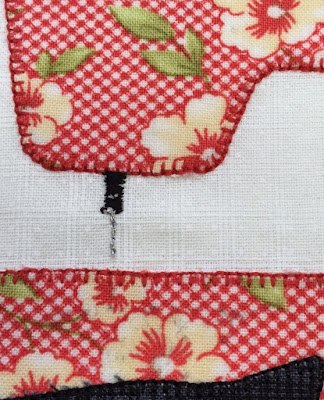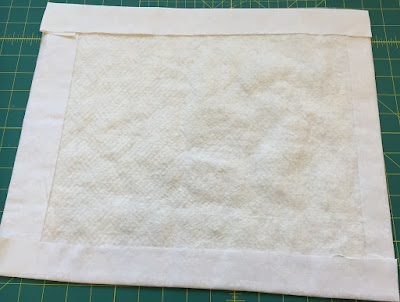I'm having too much fun with this quilt along. I mean that literally! I need to make the next block for my own "Kitty Craft" quilt along, and I desperately need a new bag or two.
Tomorrow, I work on those. Tomorrow.
The fifth block for Splendid Sampler came out on Thursday. It's a divided 9-patch, slice and dice, and it whizzed together in no time. Now and then, something easy and relaxing is exactly what the doctor ordered.
 |
| Block #5 |
|
|
And then came the sixth block in the quilt along. Oh, my. I had to make it twice. I saw too many possibilities with the layout, so I sewed it with completely different values the first time around. Once again, I was working with tiny triangles, and though I am learning and getting better at this, it was a struggle to get the points right.
I wasn't finished, though. I like the original, and I wanted one similar to that as well. So, I made it again. This time, I chose the easy way out, and paper pieced it. Slick! With paper piecing I was able to eliminate some of those tiny triangles, too.
It's hard to believe that these two blocks are from the same identical pattern!
 |
| Block #6 |
Your Blocks
From Marge Colleran
"I am using my stash and am having soooo much fun."
 |
| Marge's first four blocks |
From Dixie Moore
Dixie has sewn her first five blocks all over again using a totally new group of fabrics. Such a difference!
From Dixie:
"... my two favorite blocks thus far are #4 and #5. Who doesn’t
like appliqué, for one, and the Simple Simon block was just a delight to
stitch. Now that I am settled in with my Civil War fabrics (these come
from my flirtation with a blue and white Dear Jane quilt in 2010), I can dig in
and enjoy this project as much as many of the other gals seem to.
What
I’ve come to know thus far is just how sensitive the fabric is to rotary cutter
and board. Each cut moves the fabric a hair; the fabric must be coaxed back to
the line each time. When I do original appliqué or make mug rugs, being a
hair off is not an issue. The other thing that fascinates me is just how
powerful our machines are as we slip fabric under the foot pedal. I am
employing my oldest and smallest machine for these blocks. I think my larger
machine would eat the blocks in the blink of an eye. Moreover, while I am a
pinner, I can see the value of just carefully nesting the pieces into each
other with the opposing pressed seams. A small pin can distort, and
quickly, sabotaging the careful work that came before.
I
expect to be a much better piecer by the end of this journey, and that delights
me."
 |
| Dixie's Blocks #1 - #5 |
 |
Dixie's Block #6 |
A Tutorial
Make a paper piecing pattern for Block 6
Instructions
Print
off the block diagram that came with the pattern. Choose your fabrics
and locate where each will be placed. I wrote the letters right onto the
diagram.
Fabrics as shown on the pattern:
There are three basic pattern sections for the block.. I've shown the
pattern measurements with sketches made on graph paper. If you
aren't comfortable with a computer drawing program, you can draw your pattern like this on graph paper. I made the final pattern in color with the drawing program on Microsoft Word. I've numbered the pieces to show the order in which fabric pieces are sewn.
1. The Center Section
Draw
a square 2" x 2". Draw a diagonal line from one corner to the next.
Draw another square that is 1/4" larger on each side. The finished
pattern is 2 1/2" x 2 1/2". Make 4.
You will need to sew two of each color combination. The numbers indicate which fabric is placed first.
2. Short Side Section
Draw
a rectangle 1" x 4". Divide as shown below. Draw another rectangle
that is 1/4" larger on each side. The finished pattern is 1 1/2" x 4
1/2". Make 2.
Color placement and numbers to show the order in which fabrics are added is shown here.
3. Long Side Section
Draw a rectangle 1" x 6". Divide as shown below. Draw another
rectangle that is 1/4" larger on each side. The finished pattern is 1
1/2" x 6 1/2". Make 2.
Color placement and numbers to show the order in which fabrics are added is shown here.
Assembly
The
block is assembled exactly as shown in the original pattern. Use 1/4"
seams throughout. I laid the sections out before sewing together so that
I could keep my colors matched correctly.
 |
| I removed the paper before sewing the sections together, but it can be left in place until the block is completed. |
1. Sew the four 2 1/2" squares in the center together to make a 4 1/2" square.
2.
Sew the short side sections to either side of the center squares. Be
careful to line up the colors the way you want them to be.
3. Sew the long side sections to the opposite sides of the block.
That's it!
Any questions can be left in the comment section of this blog
or they can be sent to me via email.
klee2strings@gmail.com


















































